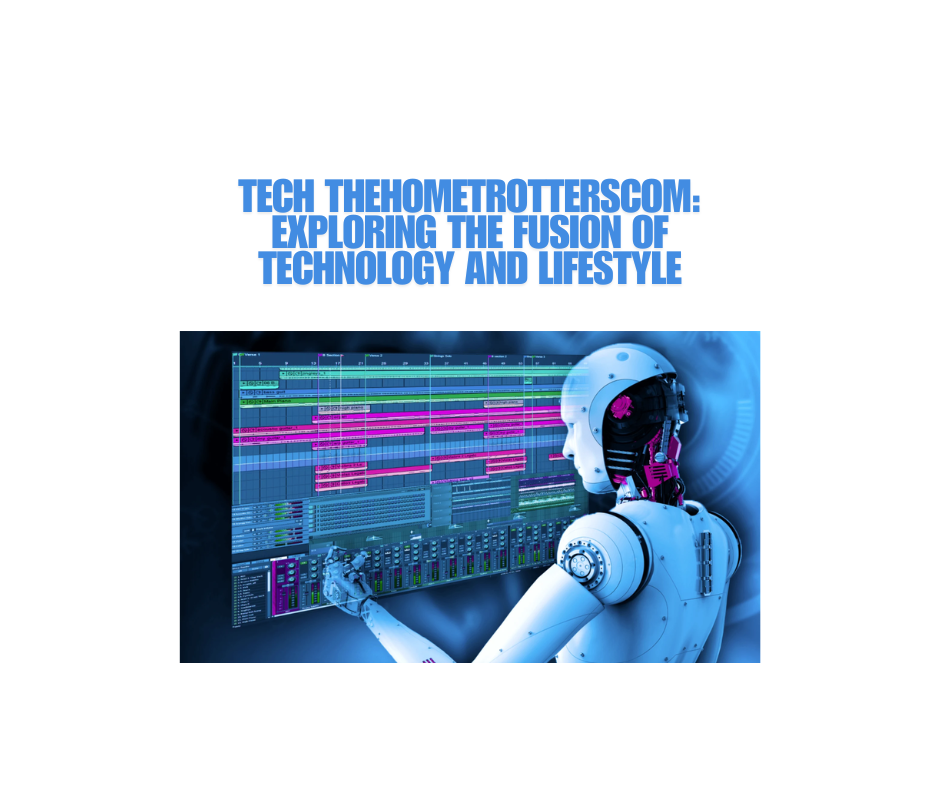In an age where technology touches nearly every aspect of our daily lives, Tech TheHomeTrotters.com stands as a guide and resource for those looking to seamlessly blend modern tech with practical, lifestyle-enhancing solutions. The website caters to tech-savvy individuals who seek to make their homes not just smarter but also more efficient, eco-friendly, and enjoyable to live in.
The niche of Tech TheHomeTrotters.com is unique—it focuses on the intersection of technology and lifestyle, exploring how innovation can elevate the way we live, work, and play at home. From smart home automation to eco-conscious gadgets and cutting-edge entertainment systems, the platform offers insights, tips, and product recommendations tailored to today’s dynamic lifestyle needs.
At its core, the mission of Tech TheHomeTrotters.com is clear: to bring cutting-edge tech solutions that enhance modern living. Whether it’s about creating a connected home that simplifies everyday routines, improving energy efficiency through intelligent devices, or curating tech for a personalized entertainment experience, the website aspires to empower its readers with knowledge and inspiration.
Exploring the Intersection of Technology and Home
The relationship between technology and our homes has undergone a remarkable transformation. The evolution of smart home technology has turned what were once futuristic dreams into everyday realities. Just a few decades ago, controlling lights or adjusting a thermostat with a smartphone seemed implausible. Today, these features are commonplace, with smart devices like Amazon Alexa, Google Nest, and Ring security systems leading the charge. This evolution stems from advancements in connectivity, artificial intelligence (AI), and the Internet of Things (IoT), which have enabled devices to communicate seamlessly and respond intuitively to human needs.
The benefits of integrating tech into everyday living are undeniable. A connected home offers unparalleled convenience, allowing tasks like locking doors, monitoring security cameras, or brewing coffee to be controlled from anywhere with a few taps on a smartphone. Beyond convenience, smart home technology improves energy efficiency, reduces utility bills, and promotes sustainability by optimizing how resources are consumed. It also enhances safety, with features like real-time alerts and 24/7 surveillance, giving homeowners peace of mind. Perhaps most importantly, these innovations create personalized environments, adjusting lighting, music, or even the temperature based on individual preferences.
AI is becoming more sophisticated, enabling predictive technology that learns from user behavior to anticipate needs. Voice assistants are evolving into central hubs, integrating with an increasing array of devices to create a unified ecosystem. Sustainability is another significant driver, with technologies focused on renewable energy and energy-saving solutions gaining traction. Finally, interoperability—devices from different manufacturers working harmoniously—is becoming a priority, ensuring that smart home setups are both scalable and user-friendly.
Top Tech Categories for Modern Homes
To fully embrace the fusion of technology and lifestyle, it’s essential to understand the key categories that define the modern smart home.
1. Smart Home Devices
AI-powered devices like Amazon Echo, Google Nest Hub, and smart thermostats such as Ecobee and Honeywell have revolutionized home automation. These gadgets enable voice-controlled operations, automate daily tasks, and enhance security with smart locks, motion detectors, and connected cameras. The ability to integrate all these features into a cohesive system has turned smart homes into hubs of convenience and efficiency.
2. Home Networking
Wi-Fi systems, such as Netgear Orbi and Google Nest Wi-Fi, ensure seamless connectivity throughout the house. Mesh networks take this further, eliminating dead zones and providing consistent speeds in large or multi-story homes. High-performance routers equipped with the latest Wi-Fi 6 technology not only boost internet speed but also handle the increasing number of connected devices without lag.
3. Eco-Friendly Tech
With growing awareness of environmental issues, many homeowners are investing in energy-saving appliances and renewable energy solutions. Smart thermostats, energy-efficient washers and dryers, and solar panels integrated with intelligent monitoring systems are transforming homes into sustainable living spaces. These technologies reduce carbon footprints while lowering energy bills, making them a win-win for both homeowners and the planet.
4. Entertainment Tech
No modern home is complete without cutting-edge entertainment technology. From ultra-HD TVs with OLED displays to immersive surround sound systems like Sonos and Bose, entertainment tech elevates how we enjoy media at home. Gaming setups, equipped with consoles like PlayStation 5 or Xbox Series X and high-refresh-rate monitors, cater to gamers seeking top-tier experiences. Coupled with smart controls, these systems create a personalized entertainment hub that caters to every mood and occasion.
Challenges in Adopting Smart Home Technology
While the promise of smart home technology is alluring, several challenges can deter homeowners from fully embracing it.
1. Cost and Affordability Concerns
One of the primary hurdles is the high initial cost associated with purchasing smart devices. From security cameras to smart thermostats, the price of building a connected home can add up quickly. Additionally, more advanced systems, like whole-home automation or custom integrations, often require professional installation, which increases expenses. Although some budget-friendly options exist, many homeowners hesitate to invest due to the perception that smart home technology is a luxury rather than a necessity.
2. Learning Curve for Non-Tech-Savvy Individuals
Smart home devices are designed to simplify life, but for those who aren’t familiar with technology, setting up and managing these devices can be overwhelming. Configuring networks, syncing devices, and troubleshooting issues require a basic understanding of tech, which can alienate non-tech-savvy individuals. The plethora of options and varying compatibility between devices can further complicate the process, leaving many unsure of where to start.
3. Privacy and Data Security Issues
With the rise of connected devices comes the growing concern of privacy and data security. Smart home devices often collect and store sensitive data, from daily routines to voice recordings. Unfortunately, this data can become a target for hackers or be mishandled by manufacturers. Homeowners are rightfully cautious about potential breaches or surveillance risks, which can dampen enthusiasm for adopting smart home technology.
Tips for Creating a Smart and Connected Home
Despite the challenges, building a smart home doesn’t have to be daunting. By following a few key steps and strategies, homeowners can create a connected space that fits their needs and budget.
1. Steps to Start with Smart Home Integration
Begin with one or two key devices that address specific needs. For example, start with a smart speaker like Amazon Echo for voice control or a smart thermostat like Ecobee for energy efficiency. Gradually add compatible devices to expand the system. Focus on creating an ecosystem where devices work seamlessly together, such as using products that integrate with platforms like Google Home or Apple HomeKit.
2. Recommendations for Budget-Friendly Setups
Smart home technology doesn’t have to break the bank. Opt for affordable options like Wyze cameras for home security or TP-Link smart plugs for automating appliances. Refurbished devices or sales events like Black Friday can also help reduce costs. Additionally, prioritize multifunctional gadgets that offer more value, such as a smart hub that doubles as a speaker and control center.
3. Importance of Regular Updates and Maintenance
To keep your smart home running smoothly, regular updates and maintenance are crucial. Ensure that devices have the latest firmware to address bugs, improve performance, and enhance security. Periodically check connections and replace outdated gadgets to maintain compatibility and reliability. Regular reviews of device settings can also ensure optimal performance while safeguarding privacy.
The Future of Technology in the Home
As technology continues to advance at a rapid pace, the future of home innovation looks both exciting and transformative. With developments in artificial intelligence (AI), the Internet of Things (IoT), and other cutting-edge technologies, tomorrow’s homes promise to be more connected, efficient, and intuitive than ever before.
Predictions for Upcoming Innovations
One of the most anticipated advancements is the rise of autonomous home systems. These systems will require minimal human input, operating seamlessly to manage daily tasks like adjusting lighting, controlling appliances, or even maintaining indoor gardens. Robots, once confined to vacuuming, will evolve into multipurpose assistants capable of performing household chores, monitoring health, or acting as companions.
Another major trend is sustainable living through green technologies. Smart solar panels integrated with energy storage systems, water-saving solutions, and devices that monitor carbon footprints will enable homes to become self-sufficient and environmentally friendly. Additionally, smart materials like temperature-regulating windows and energy-efficient construction will play a crucial role in future homes.
Enhanced virtual and augmented reality (VR/AR) applications will redefine how people interact with their spaces. For instance, homeowners could design and modify their interiors virtually before making real-world changes, or use AR to visualize how new appliances fit into their kitchens.
How AI and IoT Will Redefine Home Experiences
At the heart of the future smart home lies the synergy between AI and IoT. AI-powered systems will learn from user behaviors to anticipate needs and provide proactive solutions. For example, a smart home might detect when the occupants are on their way home and adjust the climate, lighting, and entertainment systems to suit their preferences—all without a single command.
The Internet of Things will connect every device, from refrigerators to doorbells, into a unified ecosystem. These devices will communicate with one another, creating a home environment that adapts dynamically to changing conditions. For instance, a refrigerator could detect low groceries and communicate with an AI assistant to order replacements or suggest recipes based on available ingredients.
Voice assistants, too, will evolve, offering more natural interactions and serving as comprehensive control hubs for all connected devices. Imagine issuing a single command like, “Prepare for movie night,” and watching as your smart home dims the lights, adjusts the thermostat, closes the blinds, and starts your entertainment system.
Read more: how can i disable voicemail
Conclusion
The evolution of smart home technology represents a significant leap forward in how we interact with our living spaces. By combining cutting-edge innovation with practical solutions, Tech TheHomeTrotters.com serves as a bridge between technology and lifestyle, empowering homeowners to create spaces that are smarter, more efficient, and uniquely tailored to their needs.
Throughout this journey, the website highlights not just the benefits of adopting smart home devices but also addresses the challenges that come with integrating these technologies. From understanding the cost and learning curve to tackling privacy concerns, Tech TheHomeTrotters.com equips readers with the knowledge to make informed decisions.
Looking ahead, the future of home technology is nothing short of revolutionary. Advances in AI, IoT, and sustainable innovations promise to redefine modern living, turning homes into dynamic environments that adapt seamlessly to our routines and preferences. Whether it’s making daily life more convenient, enhancing security, or promoting eco-friendly habits, the possibilities are vast and exciting.



